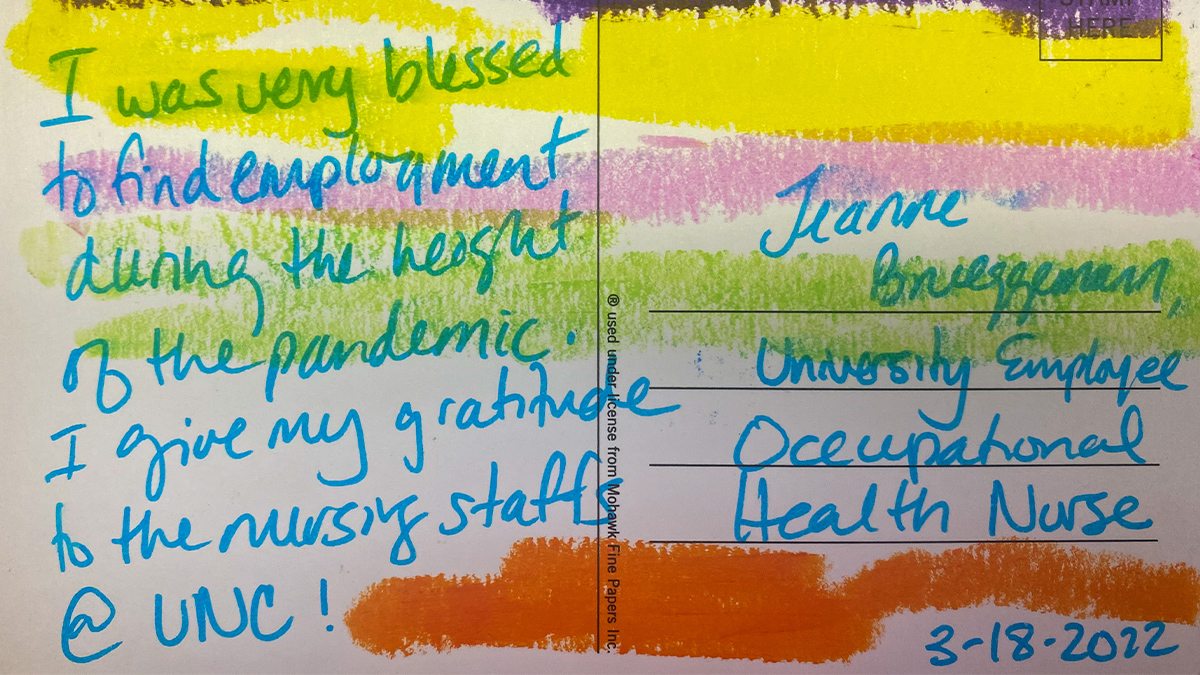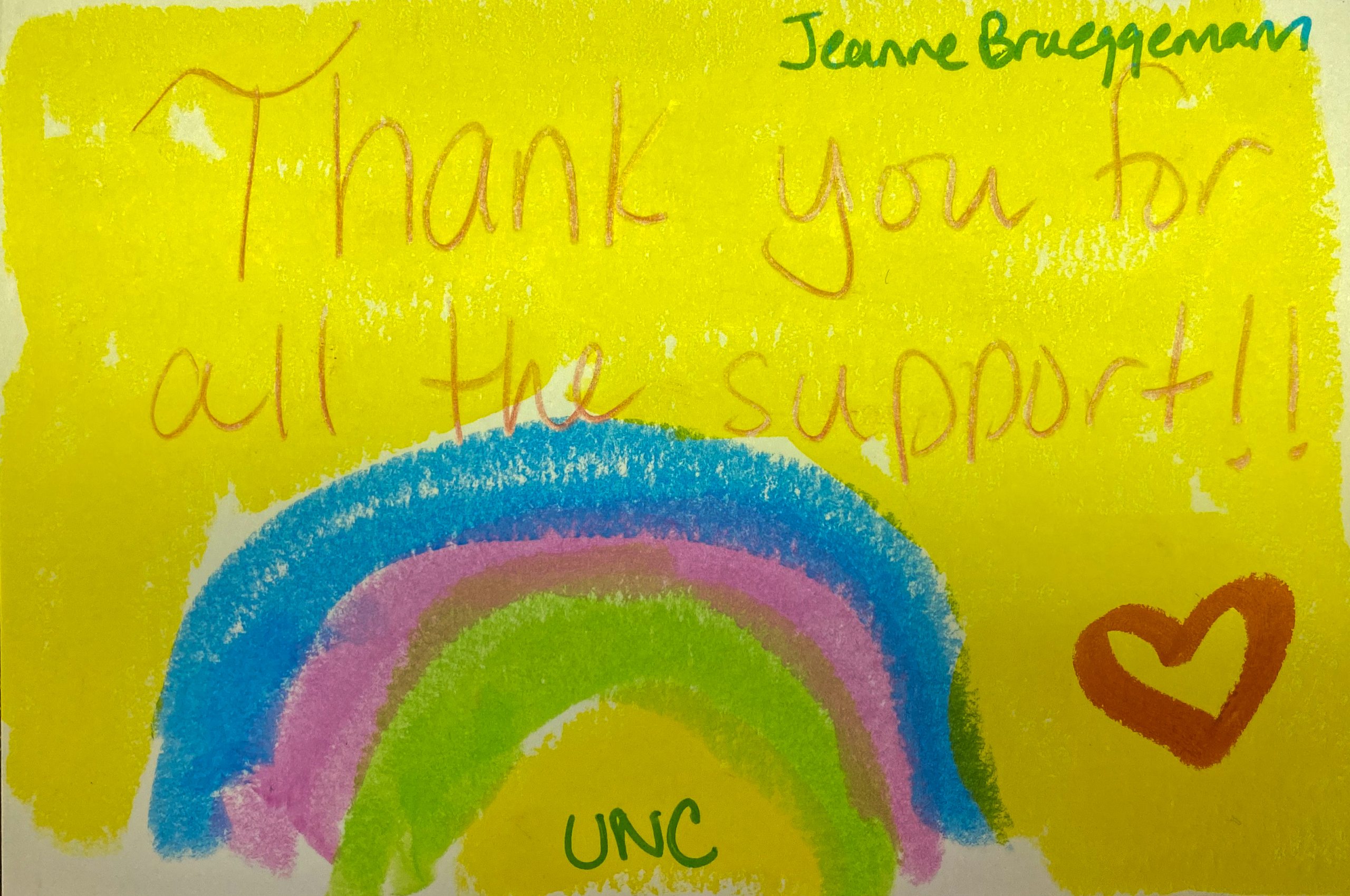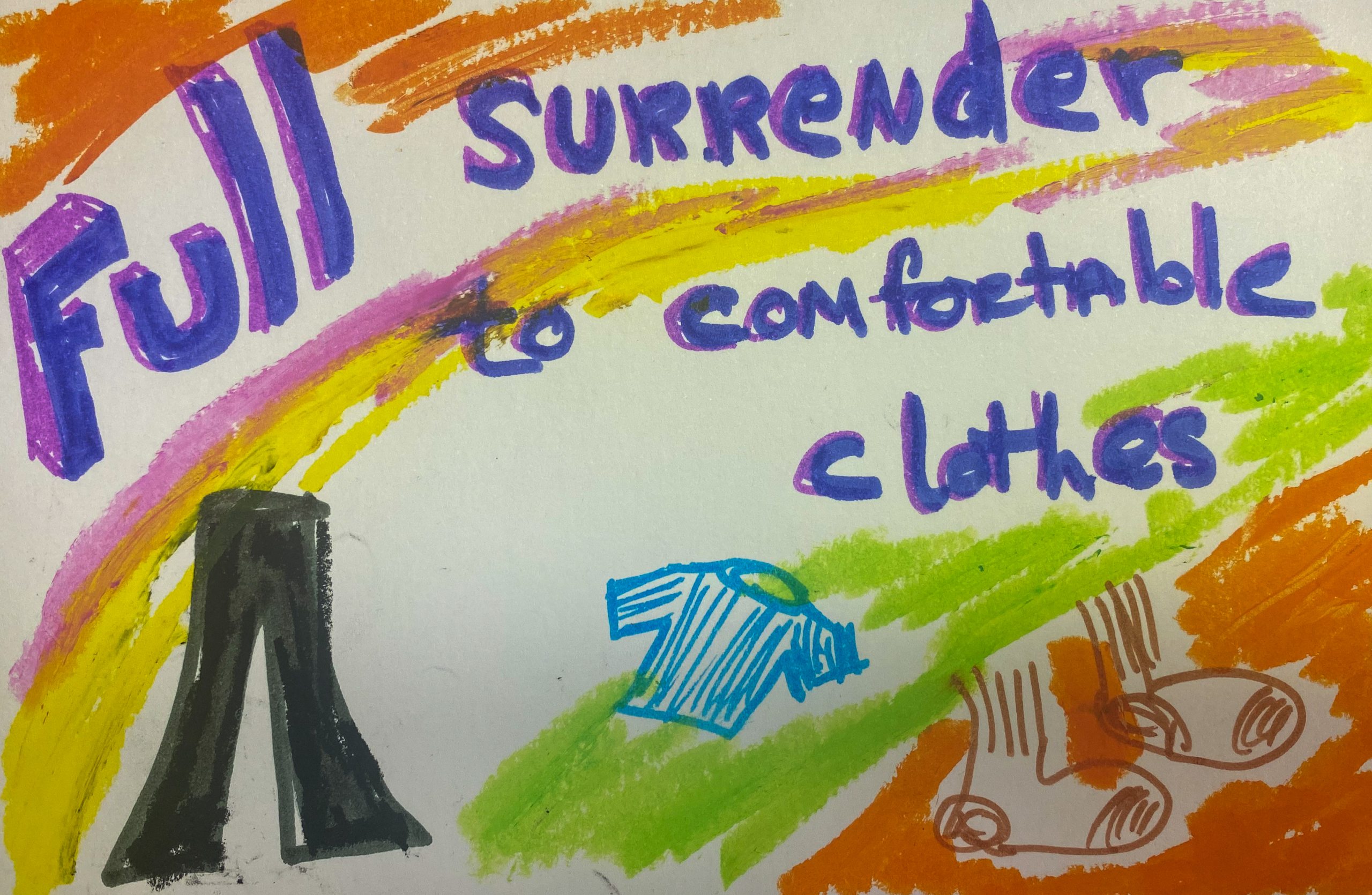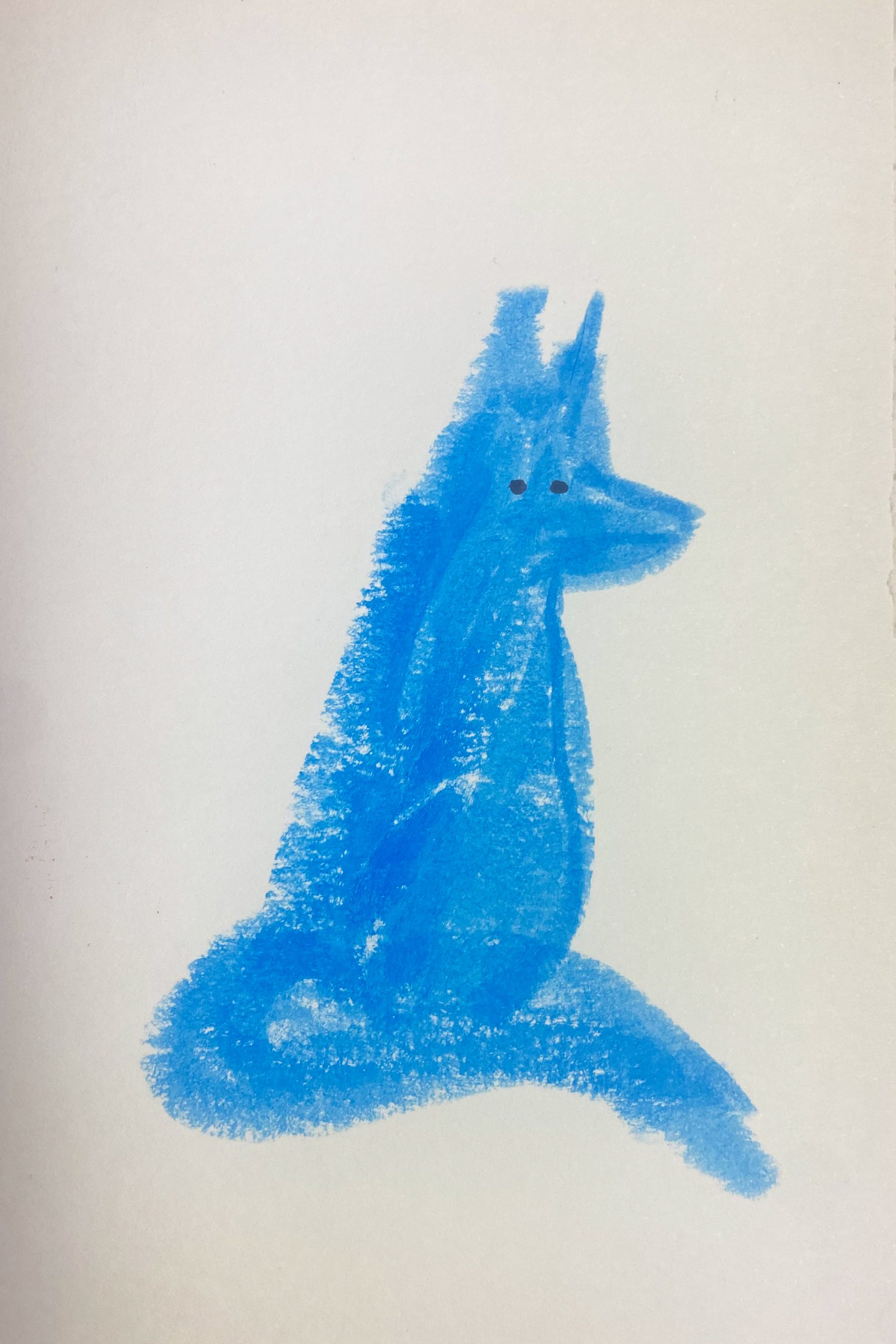EHS wins ‘Postcards from the Pandemic’ prize
The real reward for the Environment, Health and Safety team was creating therapeutic art about their pandemic experiences.

The pandemic has been hard on everyone, but one group at Carolina was uniquely affected — Environment, Health and Safety. It’s one of a minority of departments that continued to work on campus after the move to remote instruction and work began in March 2020. EHS team members followed masking and distancing guidelines to a T and often held virtual meetings with co-workers in the same building out of an abundance of caution.
So when Arts Everywhere announced its “I Was Here: Postcards from the Pandemic” project in March of 2022, EHS Executive Director Cathy Brennan saw an opportunity to foster community and boost team morale. What she didn’t know at the time was that the two dozen or so members of the EHS team, including the University Employee Occupational Health Clinic, would go on to win the project’s participation prize.
“I just thought it would be a good team-building activity for us,” Brennan said. “I thought it would be a good way to get back together and do something in-person. It looked like a really neat idea, something fun, so I set it up so that the whole department could do it.”
As the winning team, EHS received a $1,000 team fund and a $2,500 budget for artwork in their office space and in the clinic, which EHS and Arts Everywhere are currently working together to design.
EHS staff members make sure workplaces at Carolina are safe, whether that’s in emergency situations or on a day-to-day basis. The areas within EHS are risk management, biological safety, environmental affairs, occupational & environmental hygiene, chemical safety, hazardous materials, fire safety & emergency response, radiation safety and workplace safety, as well as the UEOHC.
Thoughts from team members
The EHS team works to serve the Carolina community, Kim Haley, industrial hygiene manager, said, and that’s what they continued to do throughout the pandemic — but it was harder than ever.
“We hadn’t had a chance to really get together as a team, because we were doing the 6-foot rule and all that,” Haley said. This project provided a chance to reconnect. Haley deals with indoor air quality and ventilation issues, so her postcard has pictures of lungs and respirators.
Jeanne Brueggemann is an occupational health nurse in the UEOHC, which provided guidance around COVID-19 for faculty and staff. Her job includes intake of new employees and ensuring the safety of all employees. Her postcard depicts how much she enjoyed making an impact with her team during the pandemic.

The front of Brueggemann’s postcard.
Ashley Hester, a fire safety professional, responds to fire alarms, maintains fire extinguishers and undertakes other related work. Her postcard represents significant events that happened to her and her family throughout the pandemic and the frustrations that came along with that.
“It was a nice outlet to vent for a moment,” she said, calling the experience “artistic frustration-release through the postcard.”
Aaron Gunsalus, a health physicist who helps maintain the radiation safety program, said creating a postcard “was a good way to realize what happened and remember how unfortunate and how miserable it was.”
His design was about his partner homeschooling their daughter, who started kindergarten online.
“That was painful to watch,” said Gunsalus, who also worked as a health physics technologist in the hospital during the pandemic. “I used to come home and decontaminate every day before I would get in the house after leaving the hospital.”
Brennan’s design featured her pandemic puppy. “That was one of the bright spots for me of the pandemic,” she said, coming home and having “a little puppy wanting your love and biting at you.”
Lost art form
Katie Musgrove, chair of the Employee Forum, serves as the chair of the Staff Advisory Committee to the Chancellor, which co-sponsored the project with Arts Everywhere, the Office of Human Resources and University Libraries.
Musgrove said STACC brought the idea forward during the return to campus in July of 2021. The members of the committee were looking for a way to amplify staff voices, recognize the work they did during the pandemic and make people feel connected.
“Given the disparate nature of work, with some working from home and others entirely on campus, it was a little chaotic,” Musgrove said. “And then everybody’s mental health took severe hits during the pandemic.”
STACC turned to Arts Everywhere for ideas.
“I think the arts can often help us process what’s happened,” Kathryn Wagner, associate director of Arts Everywhere, said. “There’s an impulse to use the arts as a way to express grief or to heal.”
STACC’s project subcommittee met repeatedly with Wagner and ultimately decided on the postcards idea that Wagner presented.

One of more than 500 postcards submitted by Carolina employees.
“Postcard-sending feels like a lost art form,” Wagner said. “I received postcards when I was little from my grandparents or aunts and uncles who were traveling, but I think we’re so tech-dependent now that people’s Instagram feeds are their postcards. And so going back to that whimsical, tangible way of communicating with people, I think there was something almost romantic about it.”
The project also felt approachable to staff members across all artistic abilities, which satisfied Arts Everywhere’s goal of being accessible to all.
It was an easy way for staff to participate from wherever they were, whether they were still working remotely or were back on campus, Musgrove said.
The response was substantial, with staff members sending in nearly 500 postcards.

One of more than 500 postcards submitted by Carolina employees.
“We tried to encourage freedom of expression because, in a lot of ways, the postcards had the ability to be anonymous,” Wagner said. “So if you were really angry or sad because somebody left or that you were stuck on campus working, to have safety and freedom of expression felt really important to this project.”
‘Just keep going’
On April 8, Arts Everywhere Day, the University displayed the postcards at Polk Place. But that’s not the last the community will see of them.
Nicholas Graham, university archivist, is working with a team to digitize the postcards and create a virtual gallery that people can browse. Wilson Library will also keep the physical postcards in its archives for future generations to look back on as a tangible representation of the pandemic.
“We stumbled across postcards from the 1918 pandemic,” Wagner said. “And then here we are 100 years later.”

One of more than 500 postcards submitted by Carolina employees.
Today, as a century ago, the human stories can be poignant.
During last fall’s Employee Wellness Day events, Wagner said someone approached her and showed her the front of their postcard, and then a matching tattoo of a blue fox on their arm.
“They said, ‘I was going through a really difficult time, and I would not be here if it weren’t for UNC,’” Wagner said.

“Hey blue fox — the void is terrifying. Be gentle with yourself + your fears.”
“I don’t know how to describe it, but you can tell when something is weighing heavy on somebody’s heart,” she said. “It was one of those moments that felt really important and clearly was a moment of triumph for this person, that they had overcome some obstacle and that UNC had played a really pivotal role in supporting them through whatever it was.”
The person walked away and Wagner looked at the back of the postcard.
“Hey blue fox — the void is terrifying,” it read. “Be gentle with yourself + your fears. The space between trapeze bars is where you will learn how to fly — Just keep going.”
“And it struck me,” Wagner said. “We’re all going through something. It’s that community that we all share, the University — it can be really huge and life-changing.”




